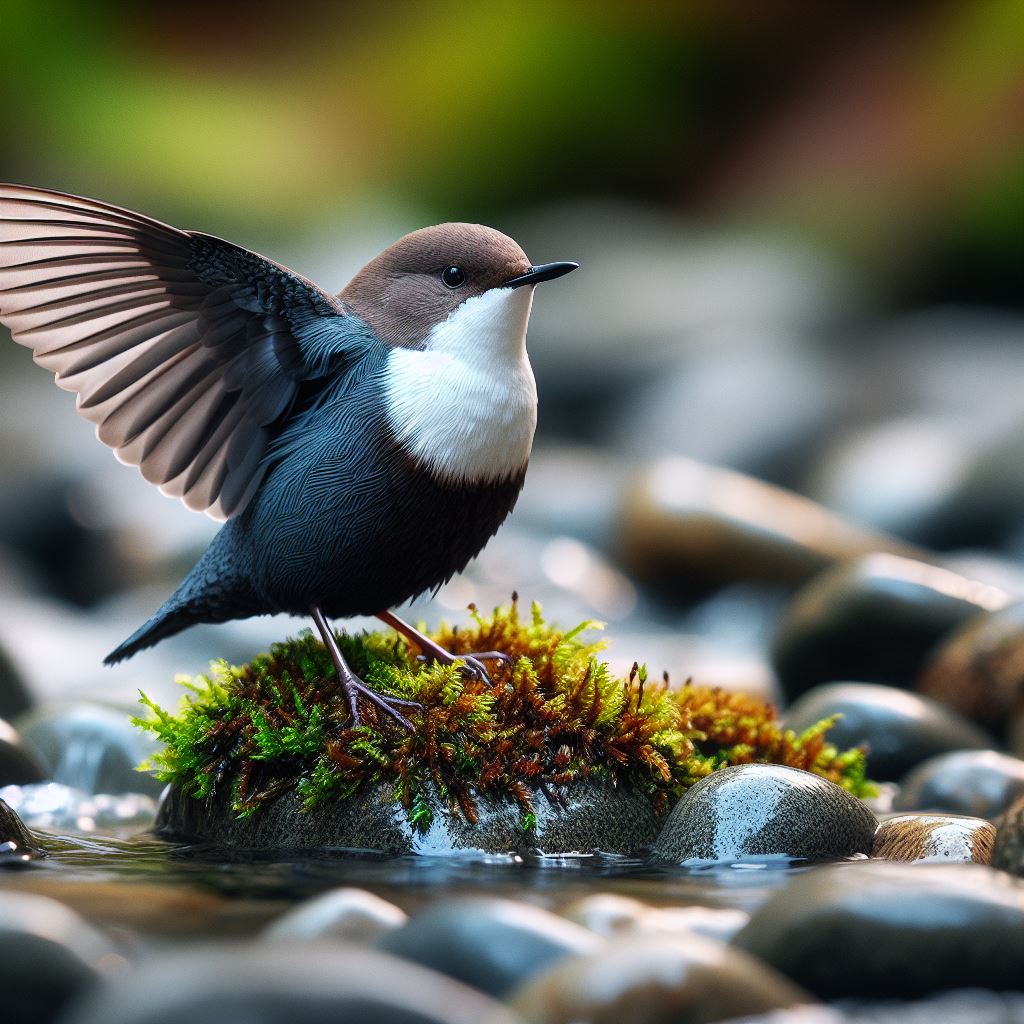Most beautiful small birds - Sykalo Eugen 2024
European Dipper (Cinclus cinclus)
Identification:
- Species name: European Dipper, Water Ouzel
- Scientific name: Cinclus cinclus
- Family: Cinclidae (Dippers)
- Order: Passeriformes (Songbirds)
- Subclass: Neornithes (Modern birds)
- Class: Aves (Birds)
Description:
- Size: Small, about 16-18 cm (6.3-7.1 in) long with a wingspan of 24-27 cm (9.4-10.6 in).
- Body shape: Plump and compact, with a short neck, a round head, and a strong, straight beak.
- Plumage color:
Upperparts: Dark slate-grey with a blue sheen.
Underparts: White, often tinged with brown.
White bib and white markings on tail and wingtips.
Short, black legs.
Dark brown eyes.
- Beak: Long, straight, and black, perfect for probing beneath the water surface.
Behavior:
- Method of feeding: Primarily aquatic, diving underwater to catch insects and crustaceans in fast-flowing rivers and streams. Also gleans insects from rocks and vegetation.
- Reproduction: Builds cup-shaped nests behind waterfalls or in crevices near water. Lays 3-5 white eggs with reddish markings. Both parents care for the young.
- Movement: Resident in most of its range, with some dispersal in response to cold weather.
- Communication: Loud and musical song with warbles, whistles, and bubbling trills. Males sing to defend territory and attract mates.
Ecology:
- Habitat: Fast-flowing rivers and streams with clear water, rocks, and moss-covered banks.
- Diet: Primarily aquatic insects and crustaceans, but also worms, snails, and fish fry.
- Hunting methods: Dives underwater using its wings for propulsion and strong legs for steering. Walks underwater along the riverbed to catch prey.
Distribution: Found across Europe, Asia, and the Middle East. Absent from most of Africa and the Arabian Peninsula.

Ah, the European Dipper — a feathered acrobat dancing on the edge of rushing waters. This unassuming brown bird might seem like a simple stream resident at first glance, but beneath its modest plumage lies a treasure trove of fascinating facts and adaptations that will leave you captivated by this aquatic dynamo:
Masters of the Mountain Streams: Forget graceful swans; Dippers are diving champions of the rushing torrents. They plunge headfirst into icy waters with incredible agility, using their powerful legs and streamlined bodies to navigate rapids and chase after aquatic prey. Imagine them as feathered torpedoes with built-in underwater jetpacks!
Unexpected Underwater Walkers: Dippers aren't just swimmers; they're accomplished underwater walkers. Using their strong legs and hooked claws, they can walk along riverbeds, peering for hidden insects and larvae beneath the surface. Think of them as feathered astronauts with built-in scuba boots and microscopic vision!
Feathered Fishermen Extraordinaire: Their diet isn't limited to tiny insects. Dippers are skilled hunters, adept at catching small fish, crustaceans, and even frogs with their quick reflexes and sharp beaks. It's like watching feathered fishermen with built-in underwater lures!
Hidden Feather Trick: Prepare to be amazed! Dipper feathers have a unique oily coating that traps air bubbles, creating an insulating layer next to their skin. This allows them to stay warm and dry even when submerged in freezing water. Talk about feathered wetsuits with built-in air pockets!
Melodic Masters of the Mountains: Don't underestimate the Dipper's vocal prowess. Their clear, bell-like songs echo through the valleys, often sung even while perched on rocks amidst raging currents. Imagine them as feathered opera singers with built-in waterproof microphones!
Symbiotic Symphony: Dippers play a vital role in the ecosystem. By controlling aquatic insect populations, they help maintain the health of streams and rivers, ensuring the survival of diverse aquatic life. These feathered water purifiers contribute to a vibrant symphony of life beneath the waves.
Hidden Vulnerability: Sadly, Dipper populations face threats like habitat loss, river pollution, and climate change. Conservation efforts are crucial to ensure these aquatic acrobats continue to dance on the edge of mountain streams for generations to come.
Unexpected Nest Architects: Dipper nests are masterpieces of ingenuity. They're built behind waterfalls or tucked into crevices by rushing waters, often made of moss and leaves carefully woven together with mud and saliva. Talk about feathered waterfall engineers with built-in waterproof cement!